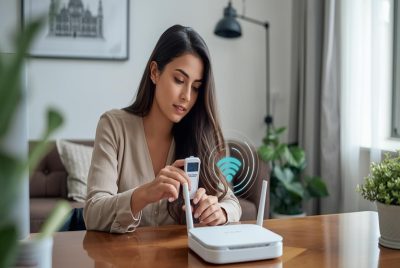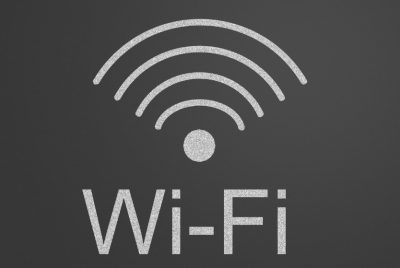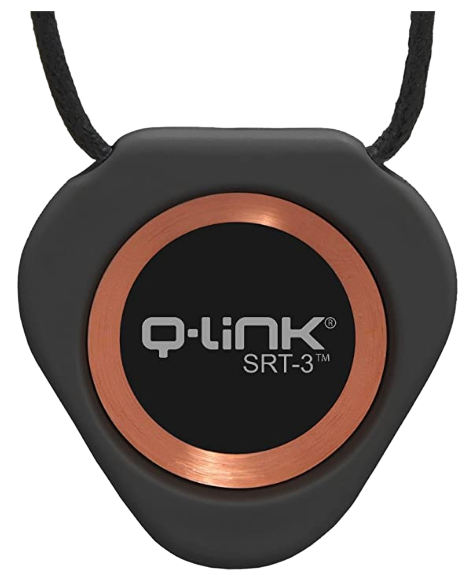We live in a world where wireless technology has become as essential as running water or…
10 Tips For Protecting Yourself From EMFs In The Workplace

Electromagnetic fields (EMFs) are an invisible aspect of our modern world, surrounded by devices and technologies that keep us connected and productive.
Though these fields are largely unavoidable, prolonged exposure has raised questions about their potential impact on our well-being.
Whether you spend your day working at a computer, surrounded by wireless devices, or near other electronic equipment, understanding how to reduce your exposure to EMFs is essential.
Taking small but mindful steps can help protect your health and create a safer work environment.
Read on to discover practical and effective tips to safeguard yourself against EMFs in the workplace.
1)) Limit Device Usage
One of the most effective ways to reduce your exposure to electromagnetic fields (EMFs) in the workplace is by limiting your usage of electronic devices.
Spending prolonged hours on laptops, smartphones, and other wireless devices can increase your EMF exposure significantly.
Whenever possible, take regular breaks away from these gadgets to minimize your contact with emitted radiation.
Consider using wired alternatives where feasible, such as corded headphones instead of wireless ones, and connect to the internet using Ethernet cables instead of Wi-Fi.
Turning off devices when they are not in use can also dramatically reduce background EMF levels.
By being conscious of your device usage and implementing small changes into your daily habits, you can create a healthier workspace with significantly reduced EMF exposure.
2)) Maximize Distance From EMF Sources
Maintaining a safe distance from EMF sources is one of the most effective ways to protect yourself from excessive exposure during work hours.
Devices such as laptops, routers, and cellphones emit higher levels of electromagnetic fields when you are close to them.
By positioning these devices away from your immediate workspace, you can significantly reduce your exposure.
For instance, placing your Wi-Fi router in a different room or at least several feet away from yourself minimizes its impact.
Similarly, using a hands-free headset or speakerphone for calls lessens the time your phone stays near your head.
Arranging your desk to keep powered devices, cables, and monitors at a reasonable distance can also make a big difference in creating a safer work environment.
Investing in tools like EMF meters can help you identify high-emission areas, enabling you to adjust your workplace setup strategically.
These small yet impactful changes can go a long way in fostering a healthier work atmosphere while maintaining your productivity.
3)) Use EMF Shields
Electromagnetic field (EMF) shields are an effective and practical solution for reducing your exposure to harmful radiation in workplace environments.
These shields work by blocking or significantly minimizing EMF emissions from devices like computers, Wi-Fi routers, and other electronic equipment.
EMF shielding products, such as laptop shields, protective fabrics, phone cases, or desk shields, are specifically designed to absorb or deflect electromagnetic waves, ensuring a safer work zone without compromising device functionality.
By integrating EMF shields into your daily routine, you can create a healthier and more balanced workspace.
This proactive measure not only contributes to your well-being but also promotes peace of mind, knowing that you’re taking steps to safeguard your health amidst constant exposure to modern technology.
4)) Opt For Wired Connections
Relying on wired connections instead of wireless technology is a highly effective strategy to reduce your exposure to electromagnetic fields (EMFs) at work.
Wireless devices, such as Wi-Fi routers, Bluetooth peripherals, and mobile hotspots, emit constant radiation as they exchange data, which can contribute to higher EMF levels in your workspace.
By opting for Ethernet cables for internet connectivity and using wired keyboards, mice, and headphones, you significantly minimize reliance on wireless signals.
This simple yet impactful adjustment not only ensures a stable and faster connection but also reduces unnecessary exposure to non-ionizing radiation.
While wireless technology offers convenience, prioritizing wired connections creates a safer environment by lowering EMF intensity and promoting better overall health during long hours at work.
5)) Avoid Prolonged Exposure
Prolonged exposure to electromagnetic fields (EMF) in the workplace can have cumulative effects on your well-being, making it crucial to establish boundaries during your workday.
One of the simplest ways to reduce exposure is by implementing regular breaks away from electronic devices such as computers, smartphones, and other EMF-emitting equipment.
These breaks allow your body to rest and recover, minimizing the time spent near potential sources of radiation.
Including simple measures like positioning your workstation farther from high EMF-producing devices, such as Wi-Fi routers or electrical panels, can significantly lower your exposure levels.
Engaging in outdoor activities or spending time in nature during breaks can also enhance your sense of balance, as natural environments are generally free from the artificial EMF emissions present indoors.
By actively managing your exposure and creating habits that prioritize downtime from devices, you can protect your health and foster a safer, more productive workplace environment.
6)) Unplug Devices When Idle
A simple yet highly effective way to minimize exposure to electromagnetic fields (EMF) in the workplace is by unplugging devices when they are not in use.
Many electronic devices, including computers, monitors, printers, and even chargers, emit EMF radiation as long as they remain plugged in, regardless of whether they are actively being used.
By taking the proactive step of unplugging these devices during idle periods, you not only reduce unnecessary EMF exposure but also contribute to conserving energy, which is beneficial for both the environment and your utility costs.
Making this a regular habit can have a cumulative positive effect on your physical well-being, as reduced EMF exposure is linked to fewer headaches, better sleep quality, and decreased stress levels.
Furthermore, encouraging this practice in a workplace setting fosters a culture of mindfulness and sustainability among colleagues, enhancing overall workplace health and productivity in the process.
7)) Position Workstations Strategically
Positioning your workstation strategically is a crucial step in minimizing exposure to electromagnetic fields (EMFs) in the workplace.
Start by ensuring that your desk is positioned at a safe distance from high-EMF emitting devices such as Wi-Fi routers, large printers, or other electronic equipment.
Placing your workstation at least several feet away from these sources can significantly reduce exposure.
Consider minimizing direct contact with devices like laptops, monitors, and phones by using accessories like external keyboards, wired mice, and monitor stands to create more space between you and the device.
Another effective strategy is to encourage the use of wired connections over wireless ones, as wired setups tend to emit lower levels of EMFs.
It’s important to assess your workspace layout and rearrange electronics to establish a safer, more health-conscious environment that prioritizes well-being while maintaining productivity.
8)) Use Plants To Absorb EMFs
Using plants to absorb EMFs is an effective and natural way to protect yourself from electromagnetic field exposure at work.
Certain plants, such as snake plants, cacti, spider plants, and peace lilies, are known for their ability to purify the air and may also help mitigate some of the effects of EMFs emitted by electronic devices.
By strategically placing these plants around your workspace, particularly near high EMF sources like computers, routers, and other electronic equipment, you can create a healthier and more balanced environment.
Beyond their potential EMF-absorbing properties, plants contribute to reducing stress, enhancing air quality, and improving overall mood, making them a valuable addition to any office space.
Adding greenery to your workspace not only serves as a protective measure but also promotes a calmer and more productive atmosphere.
9)) Take Regular Screen Breaks
Taking regular screen breaks is an effective strategy to protect yourself from the potential effects of electromagnetic fields (EMF) at work.
Prolonged exposure to screens can not only lead to physical strain, such as eye fatigue and neck discomfort, but also increase your proximity to EMF emissions from electronic devices.
Scheduling frequent breaks away from screens allows your body time to recover and reduces continuous EMF exposure.
Use these breaks to step away from your desk, stretch, hydrate, or spend a moment in natural daylight, which can help ease eye strain and improve focus.
Incorporating these pauses into your routine every 20 to 30 minutes can foster better physical health and enhance overall productivity, while also mitigating the subtle effects of prolonged EMF exposure over time.
10)) Monitor EMF Levels Frequently
Monitoring EMF levels frequently is a critical step to safeguard yourself from excessive exposure to electromagnetic fields (EMF) in the workplace.
Many devices, such as computers, smartphones, Wi-Fi routers, and other electronic equipment, emit varying levels of EMF, which can accumulate and potentially impact your well-being over time.
Using EMF meters or detectors, you can regularly assess the levels of radiation in your environment, identifying any hotspots or areas of concern.
Once identified, you can take proactive steps, such as rearranging the placement of devices, increasing your distance from high-emission equipment, or investing in shielding solutions like EMF-blocking mats or screens.
Regular monitoring also allows you to stay aware of any changes that might occur due to the addition of new devices or updates in technology.
By making EMF monitoring a routine practice, you can create a safer and more balanced workspace, optimizing both your health and productivity.
Recommendation: Tri-Field EMF Meter – Model: TF2
The Tri-Field EMF Meter – Model TF2 is a versatile device designed to detect and measure magnetic, electric, and radio/microwave fields, making it an essential tool for identifying EMF pollution in modern environments.
With its ability to monitor 4G and 5G signals, Wi-Fi routers, Bluetooth devices, and more, this meter provides accurate and reliable readings.
Its dual-mode functionality and user-friendly display ensure ease of use for both beginners and professionals.
Take control of your workplace’s electromagnetic environment today—purchase the Tri-Field EMF Meter – Model TF2 and start creating a healthier living space!
Conclusion
Protecting yourself from electromagnetic fields (EMFs) in the workplace is not just about following a set of rules—it’s about creating an environment where your health and well-being are prioritized.
By implementing the tips outlined in this article, such as reducing unnecessary device usage, maintaining safe distances from EMF sources, and utilizing protective tools, you can take proactive steps toward minimizing your exposure.
Education is equally vital; understanding how EMFs impact your body empowers you to make informed decisions and advocate for safer practices.
While technology continues to evolve, balancing its benefits with mindful safety measures is crucial for a healthier, more harmonious work environment.
Small, consistent actions can lead to long-term benefits, ensuring you can thrive both professionally and personally amidst the digital demands of modern life.





